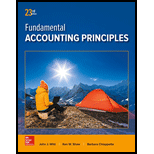
Concept explainers
Concept Introduction:
Sales variance is the difference between the budgeted sales and the actual sales. Sales variance can be because of two reasons
• Actual selling price of the product varies from the budgeted selling price and/or
• Actual quantity of sales varies from the budgeted quantity.
Therefore, sales variance is the sum of (i) Sales Price Variance and (ii) Sales Volume Variance.
Sales Price Variance:The difference between the actual selling price and the budgeted selling price is the Sales Price Variance.
Sales Volume Variance:The difference between actual quantity of sales and budgeted quantity is the Sales Volume Variance.
The following formulas are used to calculate Sales variance:
Sales Variance= Sales Price Variance+ Sales Volume Variance
Also Sales Variance = Budgeted Sales – Actual Sales
Sales Price Variance = Actual Sales - Actual quantity of Sales at budgeted price
Sales Volume Variance = Actual quantity at budgeted price -Budgeted quantity at budgeted price
Sales variance gives a view of deviations from the set standards which can be wither favorable or unfavorable
To Determine: Sales Price and Volume Variance
Want to see the full answer?
Check out a sample textbook solution
Chapter 23 Solutions
Fundamental Accounting Principles
- need explanation more and discussarrow_forwardsolve part 3 and part 4arrow_forwardQuestion: What is the date of the audit report and To whom is the audit report addressed? Urban Outfitters, Inc., is a specialty retailer, offering a wide selection of clothing, accessories, and other items. The Fiscal Year 2013 Annual Report for Urban Outfitters, Inc., can be found here. Page F-2 (page 54 in the pdf document) of that annual report contains the "Report of Independent Registered Public Accounting Firm," or the auditor's report. This report consists of four paragraphs. That page is replicated in the attached photo.arrow_forward
- No use ai Question: ABC Company has the following financial data: Cash: $30,000Accounts Receivable: $50,000Inventory: $40,000Accounts Payable: $25,000Short-term Debt: $15,000Other Current Liabilities: $20,000Calculate the following: Current AssetsCurrent LiabilitiesCurrent Ratioarrow_forwardQuestion: ABC Company has the following financial data: Cash: $30,000Accounts Receivable: $50,000Inventory: $40,000Accounts Payable: $25,000Short-term Debt: $15,000Other Current Liabilities: $20,000Calculate the following: Current AssetsCurrent LiabilitiesCurrent Ratio explain.arrow_forwardABC Company has the following financial data: Cash: $30,000Accounts Receivable: $50,000Inventory: $40,000Accounts Payable: $25,000Short-term Debt: $15,000Other Current Liabilities: $20,000Calculate the following: Current AssetsCurrent LiabilitiesCurrent Ratioarrow_forward

 AccountingAccountingISBN:9781337272094Author:WARREN, Carl S., Reeve, James M., Duchac, Jonathan E.Publisher:Cengage Learning,
AccountingAccountingISBN:9781337272094Author:WARREN, Carl S., Reeve, James M., Duchac, Jonathan E.Publisher:Cengage Learning, Accounting Information SystemsAccountingISBN:9781337619202Author:Hall, James A.Publisher:Cengage Learning,
Accounting Information SystemsAccountingISBN:9781337619202Author:Hall, James A.Publisher:Cengage Learning, Horngren's Cost Accounting: A Managerial Emphasis...AccountingISBN:9780134475585Author:Srikant M. Datar, Madhav V. RajanPublisher:PEARSON
Horngren's Cost Accounting: A Managerial Emphasis...AccountingISBN:9780134475585Author:Srikant M. Datar, Madhav V. RajanPublisher:PEARSON Intermediate AccountingAccountingISBN:9781259722660Author:J. David Spiceland, Mark W. Nelson, Wayne M ThomasPublisher:McGraw-Hill Education
Intermediate AccountingAccountingISBN:9781259722660Author:J. David Spiceland, Mark W. Nelson, Wayne M ThomasPublisher:McGraw-Hill Education Financial and Managerial AccountingAccountingISBN:9781259726705Author:John J Wild, Ken W. Shaw, Barbara Chiappetta Fundamental Accounting PrinciplesPublisher:McGraw-Hill Education
Financial and Managerial AccountingAccountingISBN:9781259726705Author:John J Wild, Ken W. Shaw, Barbara Chiappetta Fundamental Accounting PrinciplesPublisher:McGraw-Hill Education





